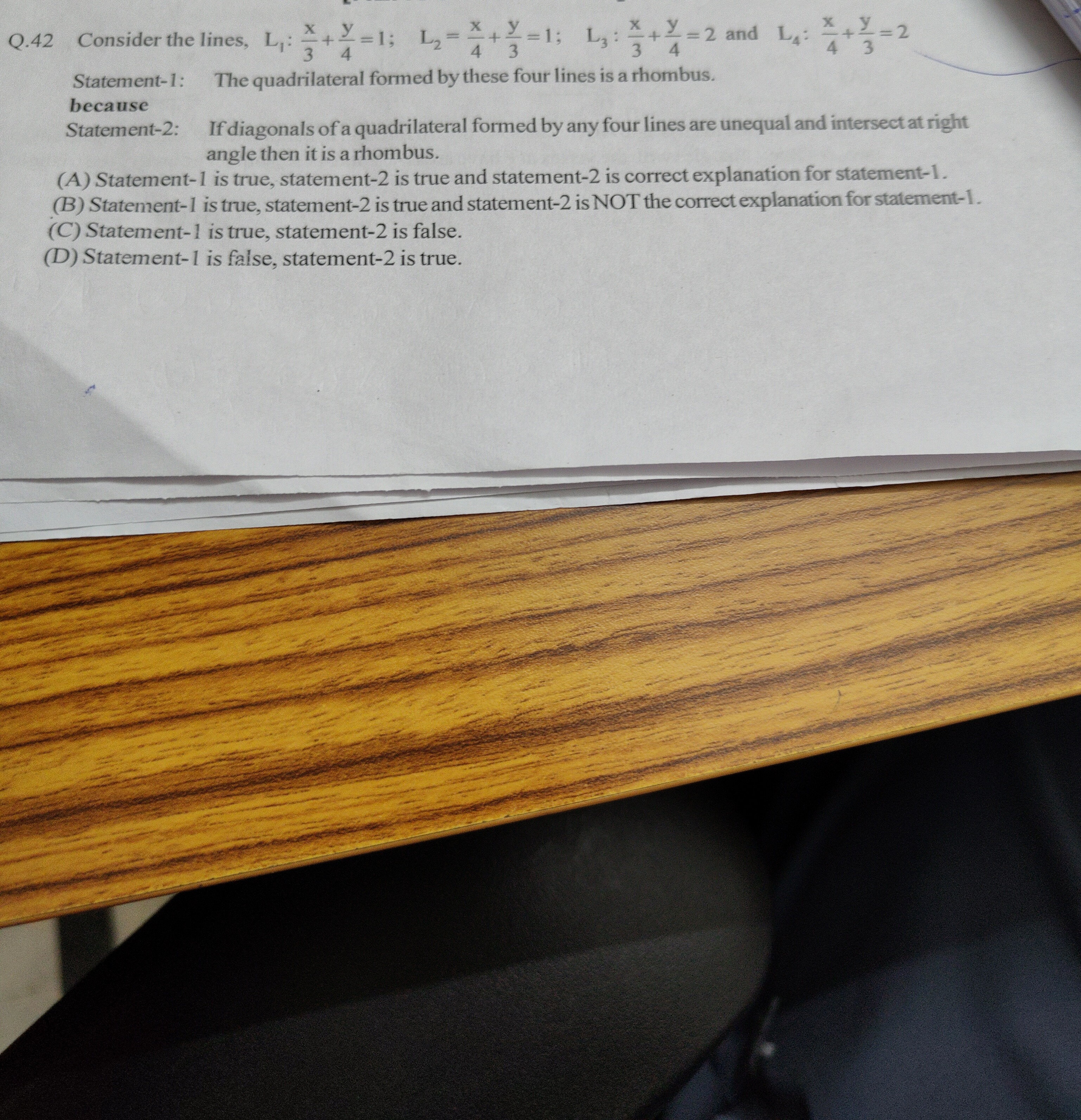Question
Question: Consider the lines, $L_1: \frac{x}{3} + \frac{y}{4} = 1; L_2: \frac{x}{4} + \frac{y}{3} = 1; L_3: \f...
Consider the lines, L1:3x+4y=1;L2:4x+3y=1;L3:3x+4y=2 and L4:4x+3y=2
Statement-1: The quadrilateral formed by these four lines is a rhombus.
because
Statement-2: If diagonals of a quadrilateral formed by any four lines are unequal and intersect at right angle then it is a rhombus.

Statement-1 is true, statement-2 is true and statement-2 is correct explanation for statement-1.
Statement-1 is true, statement-2 is true and statement-2 is NOT the correct explanation for statement-1.
Statement-1 is true, statement-2 is false.
Statement-1 is false, statement-2 is true.
Statement-1 is true, statement-2 is true and statement-2 is correct explanation for statement-1.
Solution
The four lines are given by: L1:3x+4y=1⟹4x+3y=12 L2:4x+3y=1⟹3x+4y=12 L3:3x+4y=2⟹4x+3y=24 L4:4x+3y=2⟹3x+4y=24
Lines L1 and L3 are parallel since they have the same equation form 4x+3y=k. Lines L2 and L4 are parallel since they have the same equation form 3x+4y=k. Thus, the four lines form a parallelogram.
Statement-1: The quadrilateral formed by these four lines is a rhombus. A parallelogram is a rhombus if its diagonals are perpendicular. The parallelogram is formed by the lines 4x+3y=12, 4x+3y=24, 3x+4y=12, and 3x+4y=24. Consider the general form of lines forming a parallelogram: ax+by=c1, ax+by=c2, bx+ay=d1, bx+ay=d2. Here, a=4, b=3. So c1=12,c2=24 and d1=12,d2=24. The diagonals of such a parallelogram are perpendicular if and only if (c2−c1)2=(d2−d1)2. Let C=c2−c1=24−12=12. Let D=d2−d1=24−12=12. Since C=12 and D=12, we have C2=D2. This condition implies that the diagonals of the parallelogram are perpendicular. Therefore, the quadrilateral is a rhombus. Statement-1 is True.
Statement-2: If diagonals of a quadrilateral formed by any four lines are unequal and intersect at right angle then it is a rhombus. A parallelogram with perpendicular diagonals is always a rhombus. The condition "diagonals are unequal" means that the rhombus is not a square. This does not negate the fact that it is a rhombus. Thus, Statement-2 is True.
Relationship between Statement-1 and Statement-2: The quadrilateral in Statement-1 is a parallelogram. We've shown its diagonals are perpendicular. Let's check if its diagonals are unequal. The vertices are: A: 4x+3y=12,3x+4y=12⟹A(712,712) B: 4x+3y=12,3x+4y=24⟹B(−724,760) C: 4x+3y=24,3x+4y=24⟹C(724,724) D: 4x+3y=24,3x+4y=12⟹D(760,−724)
Diagonal AC length: AC=(724−712)2+(724−712)2=(712)2+(712)2=2⋅49144=7122. Diagonal BD length: BD=(760−(−724))2+(−724−760)2=(784)2+(−784)2=122+(−12)2=144+144=288=122. The diagonals AC and BD are unequal (122=7122). The diagonals also intersect at right angles (slopes are 1 and -1).
Statement-2 states that IF diagonals are unequal AND intersect at right angles, THEN it is a rhombus. The quadrilateral in Statement-1 has unequal diagonals that intersect at right angles. Therefore, according to Statement-2, it is a rhombus. This means Statement-2 provides the reasoning for Statement-1 being true.
